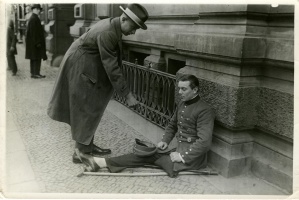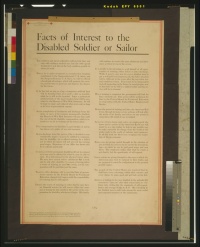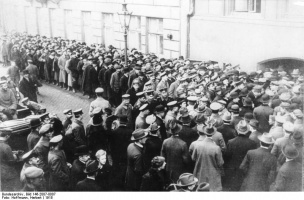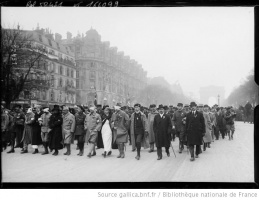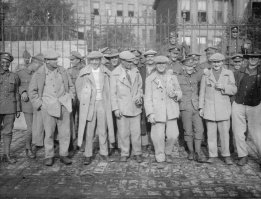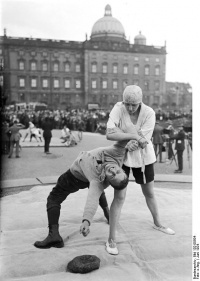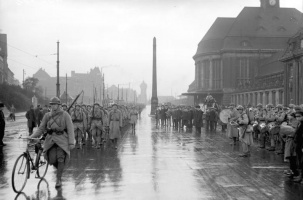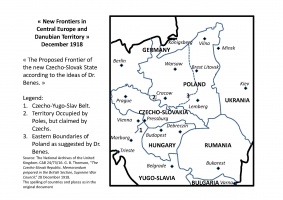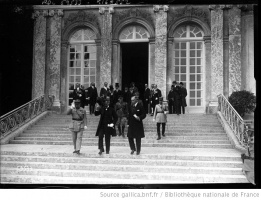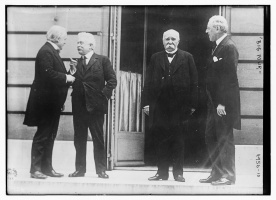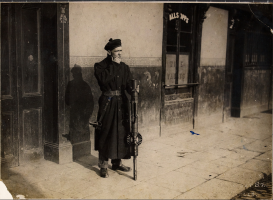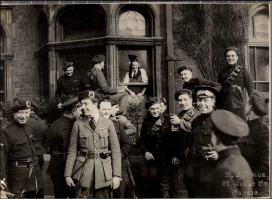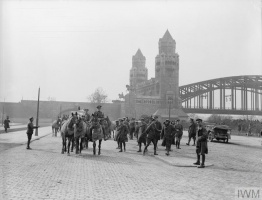Introduction↑
The process of demobilization, of converting armies, societies, and nations, from a war footing to peacetime conditions, was a massive undertaking that concerned all countries that had engaged in the First World War, be they victors, vanquished, or the successor states of empires that ceased to exist as a result of the First World War. Military demobilization was itself a complex logistical task and politicized process, balancing security with the semblance of fairness in the context of an armistice in November 1918. The end of fighting remained provisional until the signature of peace treaties. This article considers demobilization in its various guises – military, social, economic, political, and cultural – and shows how contrasting contemporary priorities influenced the various forms it took. Providing an overarching interpretative framework, part 2 offers a multidimensional definition of demobilization, including how welfare policies, provision for disability, and veterans’ movements were constitutive of demobilization and of the reorientation of national life towards the post-war era in the decade that followed 1918. It also elucidates some of the commonalities and differences in the demobilization process for different belligerents and in different parts of the world. Parts 3 and 4 survey the practical realities of military demobilization for the war’s defeated and victorious sides respectively. This transversal approach, drawing on a country-by-country analysis, places military demobilization firmly in the context of the social and economic demobilizations that ran in parallel to it. An intrinsic element of demobilization in the years 1918-20 considered in this section was the simultaneous crystallization of politically-charged myths which, even if not universally shared within these nations, reflected how many returnees from war rationalized the dislocation of defeat or their frustration at an apparently hollow or dishonoured victory. Demobilization, meanwhile, was an even more ambiguous phenomenon in the “shatterzones” of European land empires where borders were in flux and “wars after the war” beckoned. Part 5 considers how applicable demobilization is as a description in these new nations, citing some suggestive cases from central and eastern Europe. The global impact of demobilization on Europe’s overseas empires is covered in part 6. Parts 5 and 6, taken together, complement the previous focus on major European states and the USA. The seventh and final part broadens the timeframe to consider the much slower process of cultural demobilization primarily through the prism of the personal itineraries of Marc Sangnier (1873-1950) and Vera Brittain (1893-1970) setting hopes for a peaceful future, which were often bound up with the new League of Nations, in the context of the 1920s.
The Multiple Definitions of Demobilization and its Chronology↑
In his analysis of the immediate aftermath of the war, Bruno Cabanes considers that “1919 constitutes at most a step – but only a step – in what historians now call the transition from war to peace, in French la sortie de guerre [exit from war]”.[1] Alongside the major peace treaties and victory parades in home capitals like Paris, this transition period was also marked by waiting, grieving, and disillusionment. Referring to the impact on daily life of the state’s special powers, such as rationing and continued military service, Adam Seipp reminds us that
The chronology of demobilization is indeed variable not least as different armies allowed men go home at different speeds with knock-on effects for social and economic demobilizations. However, it is cultural demobilization – the process of unplugging men and women from the violence of war – that would in some way prove the most challenging aspect. In most cases, the war’s end acted as the high-water mark of a “war culture” based on violent hatred of the enemy. In 1920, grief was such that ideas of rehumanizing the enemy had to lie in the future, as we shall see in part 7.[3]
The most tangible and immediate manifestation of the end of wartime was military demobilization. This was not a politically neutral technocratic exercise: even though basic logistical considerations weighed on authorities’ choices, it was also a process fraught with competing priorities and political, economic and social imperatives. The process of military demobilization took different forms in different national or imperial contexts. More detailed national cases are examined in parts 4 and 5. Some general considerations apply across the board however. Firstly, governments were not always neatly in charge: retreating armies began to disaggregate in the last stages of the war when men saw defeat as imminent. In the cases of the Russian Empire in 1917-18 and the Central Powers in 1918, soldiers themselves were the drastic agents in their own demobilization as demobilization plans were often superseded by events on the ground. State authority fell apart in dynastic empires like Austria-Hungary, blurring further the lines of legitimate authority that might supervise demobilization. Where governments were in charge, several possibilities lay open. The French and Italian armies, for example, were demobilized by age, with length of service acting as principal determinants of how quickly a worker, peasant, or bourgeois was reunited with his family. In the British case, initially at least, labour market needs took priority in the order of release of soldiers. The US army, facing the added challenge of transatlantic transportation, released men by army unit thereby prioritizing the army’s need for coherence.[4]
In most armies, demobilization included a series of bureaucratic steps before, during, and after the transportation of men (on overcrowded trains) to clearing centres, closer to or most likely in the home country. This required quite literally re-clothing the male body with a new modest suit of clothes (save where these were rejected as too ungainly). Colonial troops of the Entente empires were made to wait longer. Everywhere, men grumbled at repetitive and delaying checks as well as at what they considered meagre demobilization allowances. Festive rituals accompanied the official return home. In the home, families tiptoed around returning husbands and fathers unsure if the war had changed them or if they were just as kind (or unkind) as before. In the moral economy of demobilization, returning soldiers were given guarantees, officially at least, that they would not be economically disadvantaged by their service to the nation, a promise that had implications for women who had taken up traditionally male employment during the war.
“Decontrol” of the economy – the relaxation of a wartime command economy – was the order of the day for liberal capitalist nations even if demobilization engendered an expansion of the welfare policies that had already begun in wartime. From unemployment to disability, Pierluigi Pironti writes, "mass society held the state responsible for the social question and the accomplishment of extensive social reforms."[5] From France to Poland to Portugal, securing the eight hour day was emblematic of such reform in 1918-19. Soviets aside, the major European combatant powers underwent processes of economic demobilization along capitalist lines, reversing some of the wartime erosion of the distinction between private and public economies. The United States, as the exemplary capitalist economy, experienced an abrupt economic transition in 1919 in which labour radicalism was crushed. For Germany, Gerald Feldman argues that decontrol meant opting consistently for free market economics: the Arbeitsgemeinschaft or "working partnership" model of the nascent German Republic set up a corporatist arrangement where business and organized labour cut deals in order to stabilize the capitalist system.[6] Charles S. Maier argues that that conservative elites actually recast bourgeois Europe in the period 1919-1924, conceding just enough to organized labour to ensure its acquiescence.[7] More recently, Adam Tooze has referred to the demobilization period as a "great deflation." Britain and France followed the lead of the United States, their major creditor, by following a deflationary wave, cutting expenditure as much as was politically feasible in order to balance budgets. The experience was particularly drastic in Great Britain whose economy slumped in 1921: the Lloyd George government jettisoned more costly parts of its "homes fit for heroes" programme leaving voters feeling cheated. This strict retrenchment was the main driver of the restoration of a type of bourgeois economic order in 1920s Europe.[8] Equally, beginning the decade-long reconstruction process in French and Belgian sectors of the Western Front in 1919-20 – a period of clearing and assessing damage – was integral to demobilization.[9]
Whilst financial orthodoxy reigned supreme, economic demobilization still had to reflect the shared sacrifices of wartime so that expanded welfare programmes became integral to demobilization as a social project: the rapidly-emerging veterans’ movements demanded no less. Veterans were, in the words of French Prime Minister Aristide Briand (1862-1932) in 1921, "the first creditors of the nation." With advocates like wounded veteran and lawyer René Cassin (1887-1976) and the Union Fédérale des mutilés (UF), amongst other organizations, French veterans won the “right to reparation” (“droit à réparation”) in a pensions law passed by parliament on 31 March 1919. Two purpose-designed agencies (Offices), established in 1916-17, for the care of war wounded and dependent children, co-opted recipients – veterans themselves – into state administration of its programmes.[10] This system of rights was particularly French but the nexus between the warfare state and the welfare state was a common transnational feature of the demobilization process. Indeed, the new International Labour Organization, established in 1919, explicitly linked social justice and lasting peace.
The rehabilitation of war-related disability was a particularly sensitive issue: here were citizens whose bodies (or, in some cases, whose minds) could never fully demobilize. In the German case, the war disabled felt obliged to embarrass governments into giving them more help in achieving dignity. 2.7 million Germans had been left with some sort of permanent disability by the end of the war. The biggest new group representing German veterans was the socialist-oriented Reichsbund des Kriegsbeschädigten und ehemaligen Kriegsteilnehmer (RKK) [Reichsbund for War Wounded and Former War Combattants] founded in 1917. In December 1918 it brought Berliners face to face with the human costs of war by staging a rally of 10,000 disabled veterans and calling for better pensions which they wanted to be financed by means of taxes on war profits.[11] Though Italy had led the way by establishing an agency for war disabled relief in 1917, it also experienced a considerable amount of left-wing veterans’ protest during demobilization with sit-ins in public buildings by disabled soldiers.[12] Deborah Cohen’s comparative study of German and British war disabled welfare shows how the Weimar Republic conducted a much more interventionist welfare policy, in part as a legitimizing project for the new regime. However, German disabled veterans were collectively much more critical of government provision whereas the charitable model at work in Britain acted as a buffer against robust criticism of considerable state neglect.[13]
Nor were soldiers the only group who desired to return home and get their due. Soldiers in captivity as prisoners of war (POWs) also hoped to do so. Those in German captivity benefitted from armistice terms which provided for their rapid release, prompting another rush to transport large amounts of men home, in some cases through Switzerland. German POWs sometimes waited for years to get home. Refugees and displaced people were also on the move in 1919, some never seeing home. Finally, civilian internees ceased to be “enemy aliens” but waited patiently for release. On Malta, for instance, at the British-run St. Clement’s Camp for Ottoman civilian internees, the slow process of repatriation dragged on into the early 1920s lengthening family separation to up to six years in cases.[14] The early stages of demobilization – 1918-19, in particular – coincided with waves of public apprehension on numerous fronts over and above those previously stated. The most lethal of these challenges was the global influenza pandemic commonly referred to as the Spanish Flu. At the same time, for conservatives, another virus – Communism, as inspired by the ongoing Russian Revolution – was on the march. The French parliamentary elections of November 1919 featured a lurid anti-Communist campaign that helped to elect a centre-right Bloc National majority. Xenophobia directed at black residents informed riots in British port cities in mid-1919. The USA experienced both an anti-Communist "red scare" in 1919 but also a "Red Summer" that year when race riots swept northern cities as part of a backlash against the Great Migration of African Americans northwards, where wartime employment opportunities beckoned. Worldwide dislocation existed alongside exaltation: on the broad left, and beyond, the establishment of the new League of Nations at Geneva in 1920 held the promise of making demobilization into a prelude to permanent peace.[15]
Demobilization Amongst the Defeated Powers↑
Germany↑
In Germany, as in other defeated powers, the process of demobilization involved most tangibly the return “home” of combatants. This coincided with (an initially bloodless) political revolution in a pattern that had parallels elsewhere amongst the Central Powers.[16] When the armistice came into effect on 11 November 1918, it fell to the German authorities to supervise, in Richard Bessel’s words, the "demobilization of an army which had largely disintegrated."[17] About 1 million men had walked home in autumn 1918. For the 6 million Germans who remained under arms by early November, the armistice agreement itself accelerated the pace of demobilization in such a manner as to maximize the advantage of the Allied and Associated Powers over Germany in advance of a peace settlement. Though the official order to demobilize was not issued until 13 December 1918, Germany demobilized its army within four months of the Armistice. By mid-January all Western Front soldiers were back within the borders of Germany while the return of men from the Eastern Front took longer owing to transport problems.[18] The men were officially demobbed by age once they reached home garrisons even if the reality was somewhat more haphazard.[19] Unsurprisingly, thousands of weapons went missing, boding ill for the peace of the home front. With official encouragement, towns and villages decorated railway stations and streets with garlands to celebrate the return to the Heimat of an allegedly undefeated army. This fiction of being undefeated was cultivated by the military and famously repeated by Friedrich Ebert (1871-1925), the moderate socialist head of the transitional government, when he welcomed returning German troops at Berlin’s Brandenburg Gate on 10 December 1918. The self-deception, intended by Ebert to salve the wounds of defeat and to co-opt soldiers’ support for the new republic, had toxic after-effects as it lent credence to the counter-revolutionary myth of the "stab in the back" by strikers on the home front.
Meanwhile, economic realities rapidly intruded on Germans’ festive reunions. On 19 November, Joseph Koeth (1870-1936), the former War Materials Ministry official promoted to head a new Reich Bureau for Economic Demobilization issued a message to returning soldiers pleading with them to have realistic expectations about the availability of provisions when they got home.[20] Persisting in regional guises up until 1922, the apparatus of economic demobilization in Germany made a virtue of “wriggling through”, mollifying key interest groups and thus averting social revolution.[21] Remarkably, while Germany had to find employment for some 6 million soldiers and the 3 million employed in armaments production, a total economic disaster was averted in the short term by means of pragmatic co-operation locally and nationally between labour, business, and the state. The Stinnes-Legien agreement of 15 November 1918, a pragmatic deal between industrialists and the major trade unions, was an element of this. Unemployment spiked briefly before falling. The process of capitalist restoration and "decontrol" came at the price of conceding a key labour demand – the eight hour day, also achieved in France – and the exclusion of women workers. Peace was bought by the government, however, at the price of funding production at any cost, which contributed to the worsening deficit in German state finances.
A series of left-wing revolts marked the 1918-19 period in Germany and, when coupled with persistent misinformation from the generals and the dashing of unrealistic expectations about the peace settlement in May 1919, all these factors combined to crystallize a Dolchstoßlegende ["stab-in-the-back legend"] amongst a large body of German nationalist opinion. Freikorps, originally often formed out of defunct imperial units in November 1918, rose to prominence as bands of irregular soldiers, made up both of veterans and of angry younger men. Repressing left-wing violence in 1919 whilst also engaging in “small wars” on Germany’s eastern frontiers, these “non-demobilized” veterans – whose importance dwindled from March 1920 once state toleration of them ended – acted as vectors of hatred of the “enemy within”.
Austria-Hungary↑
The exodus of uncaptured Austro-Hungarian imperial soldiers north from the Italian front after an armistice took effect there on 4 November 1918 was chaotic rather than an orderly official demobilization. The dramatic collapse of state power in October and early November 1918 saw the Dual Monarchy dissolved into new states reflecting its variety of national groups. The Empire’s Imperial and Royal Army (k.u.k. Armee) had been composed, since 1867, of a common army along with the separate Austrian Landwehr, Hungarian Honvéd and the common imperial navy (k.u.k. Kriegsmarine). These now fractured along national lines. A crucial moment arrived when, on 24 October, Hungarian leaders appealed to Honvéd soldiers to lay down their arms and return home, effectively ending the army as a common institution of the empire. On 31 October, Charles I, Emperor of Austria (1887-1922) admitted his powerlessness by permitting all former imperial officers to accept employment from emerging nation states.[22] Self-demobilization was the logical corollary of this turn of events. Even before the signature of the armistice with the Italians, many units of the diminished imperial army were in open revolt. Up to 400,000 fleeing imperial troops were taken prisoner in the last hours of the Italian offensive at Vittorio Veneto; 30,000 of these never saw home, dying in captivity in harsh Italian-run camps. Train transport had an anarchic air as overcrowding made for lethal accidents on the railways. Supply stores were looted while men waited. The remnant armies ran a large number of trains – taking back some 1.6 million men by mid-November even if another 460,000 Austrian troops simply walked home.[23] Their welfare and allowances, and those of their dependents, immediately became the responsibility of the new nation-states they returned to. By 1920, food shortages, especially in Vienna, were the most dramatic expression of the economic dislocation of demobilization in the core of the former empire. International aid through the new League of Nations would help stabilize the new Austrian Republic by 1923.
Germany, Austria, and Hungary also shared a common transnational experience of paramilitary units, bent on counter-revolution through the use of redemptive violence against perceived political enemies.[24] However, the official Austrian military history of the war did not subscribe to a Dolchstoß myth, stressing instead the tragic nobility of a doomed army in a doomed empire.[25] Besides, the ethnic groups most resented by Austrian loyalists for alleged treachery – such as the Czechs – were gone from the national polity due to the empire’s collapse. For Austrian veterans of a German-national persuasion, the alleged culprits in internal subversion were the striking workers of “red Vienna” and Austria’s Jewish population.[26] The Soviet Hungarian Republic of March to August 1919, meanwhile, divided Hungarians into warring Reds and Whites. The reactionary National Army under Admiral Miklós Horthy (1868-1957), which ousted the Communists, scapegoated and executed Jews. The Treaty of Trianon, signed in June 1920, reduced Hungary to about one-third of its pre-war territory and only about one-quarter of its previous population. In consequence, Hungarian nationalist grievances (common to both right and left) were projected outwards towards Romania and Czechoslovakia, and the fate of their Hungarian nationals living there, leaving little room for political or cultural demobilization.[27]
Demobilization amongst the Entente Nations↑
Great Britain↑
The Armistice of 11 November 1918 gave Britons a moment of public jubilation, yet the first stage of demobilization at the end of 1918 – devised by the Secretary for War, Lord Alfred Milner (1854-1925) – had to be rapidly revised such was the public frustration with it. By putting industry's needs first, Milner’s scheme prioritized some of the men who, by economic necessity, had been amongst the last to be called up. Disturbances within the British army camps at Calais and Folkestone, as well as a major demonstration drawing a crowd of 3,000 in London, ensued. After the first post-war election in December 1918, Winston S. Churchill (1874-1965) became the new Secretary for War in January 1919. Churchill reversed course and implemented a more acceptable demobilization scheme which factored in, most of all, length of service and number of wounds sustained.[28] British forces shrank from about 3.8 million at the Armistice to around 900,000 in late 1919 and down to 230,000 by 1922. Britain enjoyed a brief period of economic buoyancy after the Armistice. Decanting so many men into the labour market increased unemployment markedly, from just 1 percent of the labour force in May 1920 to 23 percent by May 1921. Part of the social dividend of demobilization, therefore, had to be a considerable expansion of benefits for the unemployed such as "out of work donations" for soldiers and civilians. Women workers, so prized in wartime, fared less well: by May 1919, they made up around three-quarters of the unemployed.[29] Demobilization also occasioned anxieties that the war had "brutalized" British society in general and ex-servicemen in particular.[30] The Irish War of Independence tarnished Britain’s self-image as a peaceable nation presiding over a contented United Kingdom. The notorious “Black and Tans” auxiliary police force were seen on the British left as “a potential ‘White Guard’ or ‘Freikorps’ ready to shoot the workers, as they now shot down the Irish.”[31] Such millenarian fears were indeed plausible but the balm of victory meant that they did not become reality within Britain itself.
France↑
The protracted demobilization of 5 million Frenchmen over two years from 1918-20, was part of what Bruno Cabanes calls a "mournful victory", where the dead and the weight of loss lay heavily upon the living, both soldiers and civilians.[32] At the level of the Council of Ministers, an Under-Secretary for Demobilization, Louis Deschamps (1878-1925), sat in government from early December 1918 to November 1919 at which point the post was abolished. By November 1919, two major phases of demobilization in the French army, the first between November 1918 and April 1919 and the second from July to September 1919, had reduced the amount of men in uniform by 2.5 million and 2 million respectively. Demobilization was halted in April 1919 in response to tensions over the final peace. The republic’s citizen-soldiers returned home on the egalitarian basis of length of service tempered by some special consideration for the fathers of larger families. The final demobilization took place in March 1921 when the youngest wartime class, that of 1919, was sent home, the men coming from the Salonika front being, for strategic reasons, amongst the last to get home.[33] Men were regrouped by their original army and home destinations, a laborious task considering how units had been atomized by a long war. Impatient men cramped onto train wagons without straw reacted with a splurge of petty vandalism. Barring being sent to the wrong demobilization depot back in France, men were finally discharged after a last identity check, payment of allowances owed and receipt of marching orders just in case war came again to a victorious but insecure nation.
A moral economy or “economy of gratitude” operated in connection with the reintegration of soldiers into French civilian life. Symbolic compensation could include a unit being honoured before demobilization by carrying out the official liberations of villages of Alsace-Lorraine or the march into Koblenz in the Rhineland after the Armistice.[34] A national victory parade in Paris on 14 July 1919 (though a surrogate for such a French parade in Berlin), matched with multiple local regimental homecomings, also served integrative purposes. A new law obliged employers to give returnees their old jobs back, provided they had notified their employer in writing within two weeks of demobilization. Many soldiers failed to do so. Moreover, the French economy in 1919 was itself a mutilé de guerre.[35] The process of economic demobilization had begun in late November 1918 when the wartime Ministry of Armaments had been repurposed as the new Ministry of Industrial Reconstruction, with Louis Loucheur (1872-1931) as minister. The French state could not shrink back to the liberal economic status quo ante precisely because of the costs of reconstruction. Taxes rose at a time of inflation and currency troubles. Labour won, as elsewhere, the eight hour day in 1919 but this did not head off a large railway strike that year. Fears of internal subversion by “red” forces were particularly acute during the major strike waves of 1920: civic unions drawn from the middle classes (and especially veterans) assisted the public authorities in keeping essential services open. Prime Minister Alexandre Millerand (1859-1943) pointedly recalled 1914 by terming the new crisis a “civic battle of the Marne”. Veterans who were members of the centre-right Union National des Combattants answered the call but eschewed any drift towards paramilitary violence.
Italy↑
As the smallest of the so-called Great Powers on the Entente side, Italy after the war was indeed victorious though the war’s aftermath was experienced as something akin to defeat by many Italian nationalists. This highly politicized reading has tended to obscure the extent of demobilization in Italy. The process of military demobilization, which was initially chaotic, with many unfortunate soldiers not being issued with proper pension papers, began to improve in efficiency once General Enrico Caviglia (1862-1945), a commander popular with the men, became war minister in January 1919. Caviglia created a special demobilization office within the war ministry. Already, in November-December 1918, the army in the field had been reduced from 2.15 to 1.6 million men, released in four blocks. Complicating factors affecting the pace of demobilization in the Italian case included requirements that officers with civilian expertise in the domestic economy be released first. Add to that the fact that Italy had not one, but two, armies to demobilize: the field army under the high command and the territorial military under the jurisdiction of the war minister.[36] Italy, short of money and uncertain of its new borders, resumed demobilization in June 1919. Not completed until 1921 – some men had been in uniform since the Libyan war of 1911 – overall demobilization was equitable and parting allowances were paid promptly in this second stage.[37]
On the economic front, in 1919, both Italian industry and organized labour welcomed the dismantling of state economic controls and militarized discipline they termed the “bradature di guerra"” (“trappings of war”). The Interministerial Committee for the Resolution of the War Industries gave industrialists a generous settlement to offset incomplete war contracts. As part of a demobilization dividend, Francesco Nitti (1868-1953) – prime minister from June 1919 to June 1920 – extended social insurance against accidents and unemployment whilst also telling Italians to "consume less and produce more." During his final term as prime minister from June 1920 to June 1921, Giovanni Giolitti (1842-1928) abolished the fixed price of bread, a policy change which marked a real watershed between war and post-war periods for ordinary Italians.[38] Economic demobilization was marred therefore by the perception and reality of inequality. A wave of factory occupations in September 1920 and the rise of rural socialist leagues in turn encouraged the possessing classes to recruit fascist squads to restore “order”.
The crystallization of myths and of frustrations was particularly complicated in the Italian case. The Versailles treaty was taken in nationalist quarters in particular as a radical disappointment helping to feed the powerful myth of a “mutilated peace”. Already, in December 1917, veteran, journalist, and socialist turned nationalist Benito Mussolini (1883-1945) had suggested that the future of Italy lay with the aristocracy of the trenches (Trincerocrazia).[39] By 1919, the crack-troops of the elite Arditi provided a model leadership cadre. “Arditismo Civile” was proposed in 1919 by one of its exponents, Ferruccio Vecchi (1894-1957), as a programme which would convert peacetime society to a warrior code. The rapid polarization of Italian politics in the biennio rosso normalized a cult of violence. Early fascism indeed owed as much to the mythology of the Arditi as it did to the bombastic street theatre of the occupation of Fiume, led by nationalist poet Gabriele D’Annunzio (1863-1938) in defiance of the League of Nations and the government in Rome in 1919-20.
Russian Empire/Soviet Russia↑
In the period of contested “dual power” between the Provisional Government and the Petrograd Soviet from February to October 1917, the determination of the Provisional Government to fight on in the war in the name of democracy ultimately helped to delegitimize it, especially after the failure of the Kerensky Offensive of June 1917. By late summer 1917, soldiers issued demands to the government for speedy demobilization. With growing violent protest in cities and on the land, discipline on the frontline broke down and Russian soldiers began to “demobilize” themselves. The rapid publication of Vladimir Ilyich Lenin’s (1870-1924) Decree on Peace after the Bolsheviks seized power in October 1917 led to the self-demobilization of even more units. A Congress on Demobilization sponsored by the new regime met early in 1918 after former tsarist generals were enrolled to help manage the mammoth task of demobilizing 5 million men. Yet even before the costly peace treaty dictated by Germany at Brest-Litovsk in March 1918, Soviet Russia began, on 28 January 1918, to organise a new reliable mass army of workers – the Red Army – to defend the revolution. In May-June 1918, conscription into the Red Army was introduced demonstrating the new Communist regime’s "surprising ability to re-mobilize war weary solider, workers and other supporters into large scale military forces."[40] Thus, fitful military demobilization could be experienced twice, in 1917-18 and in 1920-21.
In the case of Soviet Russia, economic demobilization was attempted before being reversed on account of the Civil War. On 9 December 1917, the Soviet government issued a decree for the conversion of wartime enterprises to peacetime production which resulted in job losses at defence plants in Petrograd and Moscow. In 1918, the pre-existing apparatus of wartime regulation became, in Peter Gatrell’s words, a tool for the Soviets "to appropriate and bend" to their own wishes. War Industry Committees became People’s Industrial Committees. Sovietized raw material committees (glavki) regulated inputs to factories. Alongside violent attacks on rural grain-producers, the establishment in August 1918 of the Extraordinary Commission for Supplying the Red Army ushered in the policy of War Communism.[41] Strikingly, the First World War practice of granting exemptions from military service for skilled workers was restored. In the social realm, with the creation of the Soviet Union in 1922, veterans’ organizations for World War veterans were outlawed. Red Army veterans were the heroes. Nonetheless, as Karen Petrone argues, “throughout the entire interwar period [in the Soviet Union], World War I was de-centered rather than forgotten.”[42] As a submerged memory, one of its limited expressions was found in early Soviet cinema, which revisited the First World War repeatedly.[43] Victims of imperialism, disabled Russian veterans of the World War were depicted sympathetically, but were also presented as passive passengers of history, unlike the fighting proletariat who had changed its course by making the revolution triumph.[44]
USA↑
With roughly 4.4 million men in uniform at the end of the war, and about 2 million of these overseas in the expeditionary force, the US government faced a logistical nightmare in organizing their return home in the face of the ravaging influenza pandemic and the requirements for ship transport. The first and comparatively easy part of demobilization had been discharging the 1.5 million men in training camps by February 1919. Relatively unprepared for demobilization, the US army adopted a policy of demobilization by unit beginning with “casuals” not attached to a particular post. Troops in England and Italy headed across the Atlantic before the main body of infantry from France did. In the meantime, men were held at hastily-constructed debarkation centres near French ports like Brest. At first, there was a strict regime of drills and target practice whilst medical checks and paperwork filled spare time. The miseries of crowded debarkation camps prompted protests and petitions from soldiers still in France such that, from February 1919, General John J. Pershing (1860-1948) followed advice to increase recreation and had special honours laid on for American units by French towns and cities. Unruly US servicemen wore out their welcome in cities like Paris, however. On 1 September 1919 the last American combat unit left France followed by the last American troops on 3 January 1920, with those from the US intervention in Northern Russia following in April 1920.[45] The wave of unrest on the American home front in 1919 was associated in particular with labour disturbances and race riots. American veterans, such as those of the American Legion, held the government to account for veterans’ welfare, prompting Congress to pass a post-dated bonus bond to servicemen in 1924. Veterans’ consciousness also lay behind the Depression-era Bonus March in Washington, D.C. in the summer of 1932.[46]
Successor States and Peripheries of Former Dynastic Empires↑
In the “shatterzones” of European dynastic empires, demobilization in fact created opportunities for returning nationalist veterans to hold onto their arms and attempt to seize as much territory as possible for their new state, or to fight for an ideological project such as Communism. A crucial practical factor was the ready availability of surplus arms in a time of rapid demobilization. In the Polish case, for example, such access to arms, augmented by the disarming of German soldiers by demobilized Polish soldiers and dedicated nationalist militias, contributed mightily to the success of the six-month Poznanian or Greater Poland Uprising of 1918-1919 which took territory off the German Reich.[47] In Ireland and Poland, moreover, 1918-19 marked both the end and the beginning of armed conflict and transition to wars of independence, albeit ones different in nature. New mobilizations could supersede the First World War and demobilization itself. Poland fought a series of border wars up until 1921. When Poland officially completed demobilization in 1922, some 800,000 had fought in the Polish army whose nucleus came from the Polish Legion that had fought with the Central Powers for part of the war until the Oath Crisis of 1917. Larger still, however, was the number of Poles who had remained in the Russian, Austro-Hungarian, and German armies.
New nation states from Poland to Czechoslovakia to Yugoslavia valorised the role of volunteer armies who had defied the imperial overlord in wartime (just as independent Ireland would do with its founders). Nevertheless, the stark fact remained that many (often more) of their co-nationals had dutifully served and suffered in the old imperial armies of the previous regime. Central European nationalist elites deferred to volunteers such as the Czech Legion as emblematic national heroes yet practical concerns brought veterans of both types together on bread-and-butter issues of welfare. Thus, in Poland, the ZIWRP movement advocated for all Polish war invalids.[48] Similar shared interests prevailed in the Yugoslav Association of War Invalids.[49]
Demobilization in the Overseas Empires↑
Demobilization was not just a series of national experiences, but also a global phenomenon. As Robert Gerwarth and Erez Manela point out in their influential collection of essays Empires at War (2014), the war itself can only be properly understood by integrating its imperial dimension, both dynastic land-based empires in Europe and European “blue water” empires, as vital parts of a transnational history of the conflict. Gerwarth and Manela, emphasising the massive involvement of colonial troops and labour both in Europe and in colonial theatres of war, especially in Africa, cite the examples of India and Egypt in 1919, as well as the brutal repression of colonial revolts by both the French and British in the 1920s to show how demobilization challenged empires’ security and legitimacy.[50] The infamous Amritsar massacre of 1919 in the Punjab was occasioned by defiance of curfew regulations that were still in force, precisely because the British had refused to demobilize the colonial home front and suspend special powers such as the curfew. Colonial soldiers themselves however, once home, were plunged back into “a social and political hierarchy that was profoundly more racist and rigid than that of the metropole or the army.”[51]
Richard S. Fogarty and David Killingray, in contrast, consider unproven the case that demobilization upset the political landscape of British and French Africa and seriously undermined white prestige. The very nature of demobilization itself was unequal. French colonial troops were often paid a bonus precisely to dispel notions of equality as citizen-soldiers. Their terms of engagement meant they were committed to fighting until peace plus six months. This allowed military authorities to demobilize Frenchmen first. It also helps explain the noteworthy presence of African soldiers in the French occupation forces in the Rhineland from 1919. For Fogarty and Killingray, demobilization in British and French Africa did not produce brutalization akin to Italy and Germany precisely because the state monopoly on violence was confirmed by the war. Emblematically some (perhaps fortunate) veterans became policemen and were even more attached to the established imperial power as a result of the status, and limited material advantages, foreign service conferred upon them within their own communities.[52] Recent in-depth case studies of political activism in French North Africa, however, have shown how demobilization contributed directly to interwar anti-imperial discontent. In the case of Algeria, a territory long integrated into France but with an unequal ranking of citizens and subjects, Dónal Hassett shows how Algerian Muslims “recognized the potential to negotiate a new form of imperial citizenship” as a concomitant of demobilization and as a dividend of wartime service.[53] In the case of the wartime volunteer soldier-turned-Communist and Tunisian nationalist Muhktar al-Ayari (c.1889-c.1960), Chris Rominger discerns the more general emergence of radical dissenters who, disgusted at the poor recompense for their service, "expressed a profound sense of betrayal" at the hands of the French and of his more moderate countrymen.[54] On balance, demobilization was more subtly disruptive of empire than Fogarty and Killingray consider it to have been.
Cultural Demobilization↑
Cultural demobilization was not alone the cooling of passions but also the inversion of the war culture. John Horne has described it as akin to “demobilizing the mind” and argues that if other types of demobilization were necessary preconditions of peace, then “cultural demobilization (or its absence) determined what type of peace it would be.”[55] It needed time and came in fits and starts. “Sacrifice” would have to be rehabilitated so as not to be the pretext for perpetual enmity.[56] “Cultural demobilizers” had been “mobilized” in the first place: wartime pacifists were in a somewhat different category even if, as attitudes evolved in the 1920s, the odium that had surrounded not serving in wartime declined. Pacifists could gain a more respectful hearing, if not a mass following, from their peers. In the international academic sphere, university scholars gradually and sometime painfully restored transnational networks between the previously warring camps, broken in 1914.[57]
Horne’s chronology of cultural demobilization pivots around the Franco-German détente of the mid-1920s, though it has wider applications. In the Locarno Treaty process of 1925, French and German Foreign Ministers Aristide Briand and Gustav Stresemann (1878-1929) tried to turn the page on the bitter reparations disputes of the early 1920s and proposed reconciliation based on hard-headed realism and a heartfelt desire not to repeat the horror of war. War veteran Marc Sangnier, a French Catholic activist and Christian Democrat politician, had been out of sync with public opinion in France in January 1921 when he advocated "the disarmament of hatred" between the two nations. His Democratic International for Peace was in vogue by mid-1920s. Consciously copying German models so as to provide affordable places for French and German youths to meet, Sangnier opened the Épi d’Or youth hostel, France’s first, at Bierville outside Paris in 1929 as part of a Foyer de la Paix.[58] Erich Maria Remarque’s (1898-1970) novel All Quiet on the Western Front (1928), and its 1930 Hollywood movie adaptation directed by Lewis Milestone (1895-1980) – both runaway successes – presented war as a betrayal of the young. Some, but not all, parts of public opinion (in the Anglophone world especially) came to consider the war dead as victims of war itself, rather than of the erstwhile enemy.
In her influential pacifist memoir Testament of Youth (1933), Vera Brittain, a former frontline nurse, gave a visceral evocation of personal loss in wartime. The writer spent evenings in the early 1920s engaged in League of Nations Union activism in draughty municipal halls across Britain. Reporting on her first League of Nations Assembly in Geneva in September 1923, Brittain wrote how she was "indescribably moved by a sense of a common purpose which had given its deceptive glamour to the War, and now, struggling through the anti-social hostilities of competitive nationalism, seemed almost to have reached a point where it could be mobilised in the cause of peace."[59] In 1936, Brittain later renounced her support for collective security – with its threat of military sanctions – in favour of the integral pacifism of the Peace Pledge Union, putting herself at odds with public opinion again during the Second World War. Many other “demobilizers”, however, ultimately supported resisting fascism with force.
Conclusion↑
Demobilization after the First World War involved first and foremost the massive logistical undertaking of military demobilization involving millions of soldiers, prisoners, and civilian internees. It was not only that, however. A multidimensional definition of demobilization integrating the social, economic, and cultural processes shows how the reinsertion of millions of former combatants into civilian societies was bound up with a moral economy. An "economy of gratitude" meant that issues such as welfare, regulation of the labour market, and the roles to be played by veterans as a major new social group in peacetime society were prominent. Pensions and the care of disabled soldiers formed key parts of the agenda for new veterans’ movements which prompted governments to expand and extend the wartime welfare programmes whilst removing other wartime economic controls. Military demobilization itself was not a politically neutral exercise but depended on political priorities and security needs. Whereas Entente powers demobilized over a number of years, precisely because they required the threat of force to the defeated powers to remain, the Central Powers demobilized in a matter of months in accordance with the armistice agreements. German and Austro-Hungarian demobilizations were largely improvised for this reason, coinciding with political revolutions. The protracted demobilizations of Britain, France, Italy, and the USA produced considerable impatience amongst men and their families. Soldiers from the Entente’s overseas empires returned home later than European soldiers, the whole experience capable of generating as much alienation as attachment to the imperial power. The Russian case and those of successor states of former dynastic empires such as Poland were much more ambiguous as new conflicts superseded the old. Demobilization did not become irrevocable until the signature of peace treaties. Political myths and scapegoating also crystallized in this period, especially on the defeated side. Cultural demobilization – the cultural shift to making war itself the true enemy whilst honouring the war dead – operated over a longer chronology still, being frequently contested as treasonable. The political détente between France and Germany occasioned by the Locarno Treaty of 1925 was reflected in exchanges and congresses initiated by internationalist, religious, and feminist groups. Demobilization could inculcate grievance as well as gratitude, however. Even when it disarmed soldiers, it did not always demobilize minds.
Gearóid Barry, National University of Ireland
Section Editor: Elise Julien
Notes
- ↑ Cabanes, Bruno: 1919. Aftermath, in: Winter, Jay (ed.): The Cambridge History of the First World War. Global War, volume 1, Cambridge 2014, pp. 172-90.
- ↑ Seipp, Adam: The Ordeal of Peace. Demobilization and the Urban Experience in Britain and Germany, 1917-1921, London et al. 2009, p. 1.
- ↑ Cabanes, Bruno: La Victoire endeuillée. La sortie de guerre des soldats français (1918-1920), Paris 2004.
- ↑ Cabanes, Bruno: Démobilisation et retour des hommes, in: Audoin-Rouzeau, Stéphane / Becker, Jean-Jacques (eds.): Encylopédie de la Grande Guerre, 1914-1918, Paris 2004, pp. 1047-1062, here at pp. 1047-8.
- ↑ Pironti, Pierluigi: Post-war Welfare Policies (Version 1.1), in: 1914-1918-online. International Encyclopedia of the First World War, ed. by Ute Daniel, Peter Gatrell, Oliver Janz, Heather Jones, Jennifer Keene, Alan Kramer, and Bill Nasson, issued by Freie Universität Berlin, Berlin 2017-03-21. DOI: 10.15463/ie1418.10358/1.1 (retrieved 26 October 2018).
- ↑ Feldman, Gerald: Economic and social problems of German demobilization, 1918-1919, in: Journal of Modern History 47/1 (1975), pp. 1-47.
- ↑ Maier, Charles S.: Recasting bourgeois Europe. Stabilization in France, Germany, and Italy in the decade after World War One, Princeton 1975.
- ↑ Tooze, Adam: The Deluge. The Great War and the Remaking of the Global Order, London 2014, pp. 353-73.
- ↑ Horne, John: The living, in: Winter, Jay (ed.): The Cambridge History of the First World War. Global War, volume 3, Cambridge 2014, pp. 592-617, here at pp. 604-6.
- ↑ Prost, Antoine: René Cassin and the victory of French citizen-soldiers, in: Eichenberg, Julia / Newman, John Paul (eds.): The Great War and Veterans’ Internationalism, Basingstoke 2013, pp. 19-31.
- ↑ Stevenson, David: 1914-1918: the history of the First World War, London 2004, pp. 559-60.
- ↑ Salvante, Martina: The Italian Associazone Nazionale Mutilati e Invalidi di Guerra and its international liaisons in the post-Great War era, in: Eichenberg, Julia / Newman, John Paul (eds.): The Great War and Veterans’ Internationalism, Basingstoke 2013, pp. 162-83.
- ↑ Cohen, Deborah: The War Come Home: Disabled Veterans in Britain and Germany, 1914-1939, Berkeley 2001.
- ↑ Proctor, Tammy: Civilians in a World at War, 1914-1918, New York 2010, p. 236.
- ↑ Clavin, Patricia: Europe and the League of Nations, in: Gerwarth, Robert (ed.): Twisted Paths. Europe, 1914-1945, Oxford 2007, pp. 325-54.
- ↑ Bessel, Richard: Germany after the First World War, Oxford 1993, pp. 69-90.
- ↑ Ibid., p. 89.
- ↑ Bessel, Richard: Demobilization, in: Hirschfeld, Gerhard / Krumeich, Gerd / Renz, Irina (eds.): Brill’s Encyclopedia of the First World War, volume 1, Leiden 2012, pp. 458-61.
- ↑ Bessel, Germany, p. 79.
- ↑ Ibid., p. 79.
- ↑ Ibid., p. 106.
- ↑ Herwig, Holger: The First World War: Germany and Austria-Hungary 1914-1918, London 1997, p. 437.
- ↑ Ibid., p. 439.
- ↑ Houlihan, Patrick J.: Was there an Austrian stab-in-the-back myth? Interwar military interpretations of defeat, in: Bischof, Günther / Plasser, Fritz / Berger, Peter (eds.): From Empire to Republic. Post-World War I Austria, Innsbruck 2010, pp. 67-89, here at p. 80, referring to argument in Gerwarth, Robert: The Central European Counter-Revolution. Paramilitary Violence in Germany, Austria and Hungary after the Great War, in: Past and Present 200/1 (2008), pp. 175-209.
- ↑ Houlihan, Was there an Austrian stab-in-the-back myth?, p. 71.
- ↑ Ibid., p. 77.
- ↑ Horel, Catherine: Horthy, Miklós, in: 1914-1918-online. International Encyclopedia of the First World War, ed. by Ute Daniel, Peter Gatrell, Oliver Janz, Heather Jones, Jennifer Keene, Alan Kramer, and Bill Nasson, issued by Freie Universität Berlin, Berlin 2016-03-22. DOI: 10.15463/ie1418.10869 (retrieved 26 October 2018); Fischer, Conan: Europe between Democracy and Dictatorship, West Sussex 2010, p. 119; Gerwarth, The Vanquished: Why the First Wold War Failed to End, New York 2016, pp. 207-8.
- ↑ Demobilisation in Britain, issued by the National Archives, online: https://www.nationalarchives.gov.uk/pathways/firstworldwar/spotlights/demobilisation.html (retrieved: 1 March 2018).
- ↑ Pironti, Post-war Welfare Policies 2017. (Part 2: Labour and Unemployment Policies); Stevenson, 1914-1918 2004, p. 543.
- ↑ Lawrence, Jon: Forging a Peaceable Kingdom: War, Violence, and Fear of Brutalization in post-First World War Britain, in: Journal of Modern History 75/3 (2003), pp. 557-589.
- ↑ Ibid., pp. 582-83.
- ↑ Cabanes, Victoire endeuillée 2004.
- ↑ Cabanes, Démobilisation et retour des hommes 2004, pp. 1047-1062: Greenhalgh, Elizabeth: The French Army and the First World War, Cambridge 2014, pp. 370-75.
- ↑ Cabanes, Bruno: Les vivants et les morts. La France au sortir de la Grande Guerre, in: Audoin-Rouzeau, Stéphane / Prochasson, Christophe (eds.): Sortir de la Grande Guerre. Le monde et l’après-1918, Paris 2008, pp. 27-45.
- ↑ Martin, Benjamin F.: France and the Après Guerre: Illusions and Disillusionment, Baton Rouge 1999, p. 29.
- ↑ Gooch, John: The Italian Army and the First World War, Cambridge 2014, pp. 310-314.
- ↑ Ibid., pp. 310-314.
- ↑ Degli Esposti, Fabio: Post-war Economies (Italy), in: 1914-1918-online. International Encyclopedia of the First World War, ed. by Ute Daniel, Peter Gatrell, Oliver Janz, Heather Jones, Jennifer Keene, Alan Kramer, and Bill Nasson, issued by Freie Universität Berlin, Berlin 2015-06-22. DOI: 10.15463/ie1418.10667 (retrieved 26 October 2018)
- ↑ Jones, Mark: From Caporetto to Garibaldiland: interventionist war culture as a culture of defeat, in: European Review of History / Revue européenne d'histoire 15/6 (2008), pp. 659-674, here at p. 663, DOI: 10.1080/13507480802500400.
- ↑ Gatrell, Peter: Russia’s First World War. A Social and Economic History, Harlow 2005, p. 231; Rosenberg, William G.: Paramilitary violence in Russia’s Civil Wars 1918-1920, in: Gerwarth, Robert / Horne, John (eds.): War in Peace. Paramilitary Violence in Europe after the Great War. 1st ed. Greater War, Oxford 2012, pp. 21-51, here at p. 23.
- ↑ Gatrell, Russia’s First World War 2012, pp. 224, 232.
- ↑ Petrone, Karen: The Great War in Russian Memory, Bloomington 2011, p. 7.
- ↑ Sumpf, Alexandre: War disabled on screen. Remembering and forgetting the Great War in Russian and Soviet cinema, 1914-1940, in: First World War Studies 6/1 (2015), pp. 57-79, here at pp. 57-79, DOI: 10.1080/19475020.2015.1047889.
- ↑ Ibid., p. 59.
- ↑ Keene, Jennifer D.: World War One, Westport 2006, pp. 182-87; Sparrow, John C.: History of Personnel Demobilization in the United States Army, Washington D.C. 1952, pp. 11-19.
- ↑ Keene, Jennifer D.: A “Brutalizing” War? The USA after the First World War, in: Journal of Contemporary History 50/1 (2015), pp. 94-98, DOI: 10.1177/0022009414546506.
- ↑ Healy, Róisín: Late Sleepers and Early Risers: The Easter Rising and the Poznanian Uprising of 1918-1919 Compared, in: Dal Lago, Enrico / Healy, Róisín / Barry, Gearóid (eds.): 1916 in Global Context. An Anti-Imperial Moment, Oxford 2018, pp. 208-21.
- ↑ Eichenberg, Julia: Polish Eagles and Peace Doves: Polish Veterans between Nationalism and Internationalism, in: Eichenberg, Julia / Newman, John Paul (eds.): The Great War and Veterans’ Internationalism, Basingstoke 2013, pp. 77-96.
- ↑ Newman, John Paul: Allied Yugoslavia: Serbian Great War Veterans and their internationalist ties, in: Eichenberg, Julia / Newman, John Paul (eds.): The Great War and Veterans’ Internationalism, Basingstoke 2013, pp. 97-117.
- ↑ Gerwarth, Robert / Manela, Erez: Introduction, in: Gerwarth, Robert / Manela, Erez (eds.): Empires at War, 1911-23, Oxford 2014, pp. 1-16, at p. 12.
- ↑ Ibid., p. 13.
- ↑ Fogarty, Richard S. / Killingray, David: Demobilization in British and French Africa at the End of the First World War, in: Journal of Contemporary History 50/1 (2015), pp. 100-123, here at p. 106, DOI: 10.1177/0022009414552868.
- ↑ Hassett, Dónal: Defining Imperial Citizenship in the Shadow of World War I. Equality and Difference in the Debates around Post-War Colonial Reform in Algeria, in: Barry, Gearóid / Dal Lago, Enrico / Healy, Róisín (eds.): Small Nations and Colonial Peripheries in World War I, Leiden/Boston 2016, pp. 263-80.
- ↑ Rominger, Chris: Paths Not Taken: Mukhtar Al-Ayari and Alternative Voices in Post-War Tunisia, in: Barry, Gearóid / Dal Lago, Enrico / Healy, Róisín (eds.): Small Nations and Colonial Peripheries in World War I, Leiden/Boston 2016, pp. 245-62.
- ↑ Horne, John: Demobilizing the Mind. France and the Legacy of the Great War, 1919-1939, French History and Civilization, 2 (2009), pp. 101-19.
- ↑ Ibid., p. 103.
- ↑ Irish, Tomás / Chagnon, Marie-Ève (eds.): The Academic World in the era of the Great War, London 2018.
- ↑ Barry, Gearóid: The Disarmament of Hatred. Marc Sangnier, French Catholicism and Legacy of the First World War, 1914-1945, Basingstoke 2012, p. 160.
- ↑ Brittain, Vera: Testament of Youth. An Autobiographical Study of the Years 1900-1925, First ed., 1933, new ed., London 2014, p. 512.
Selected Bibliography
- Cabanes, Bruno: La victoire endeuillée. La sortie de guerre des soldats français, 1918-1920, Paris 2004: Seuil.
- Cohen, Deborah: The war come home. Disabled veterans in Britain and Germany, 1914-1939, Berkeley 2008: University of California Press.
- Doucet, Marie-Michèle: Les femmes pacifistes et les parlementaires français. L’exemple du projet de loi Paul-Boncour de 1927, in: Parlement(s). Revue d’histoire politique 26/2, 2017, pp. 107-123.
- Eichenberg, Julia / Newman, John Paul (eds.): The Great War and veterans' internationalism, Basingstoke; New York 2013: Palgrave Macmillan.
- Healy, Maureen: Civilizing the solider in post-war Austria, in: Wingfield, Nancy M. / Bucur-Deckard, Maria (eds.): Gender and war in twentieth-century Eastern Europe, Bloomington 2006: Indiana University Press, pp. 47-69.
- Horne, John: Demobilizing the mind. France and the legacy of the Great War, 1919-1939, in: French history and civilization. Papers from the George Rudé Seminar 2, 2009, pp. 101-119.
- Seipp, Adam: The ordeal of peace. Demobilization and the urban experience in Britain and Germany, 1917-1921, Farnham 2009: Ashgate.
- Siegel, Mona L.: The moral disarmament of France. Education, pacifism, and patriotism, 1914-1940, Cambridge; New York 2004: Cambridge University Press.
- Ziemann, Benjamin: Contested commemorations. Republican war veterans and Weimar political culture, Cambridge; New York 2013: Cambridge University Press.






